![]() 1st Battalion 22nd Infantry
1st Battalion 22nd Infantry ![]()
Benjamin A. Poore --- 22nd Infantry 1908-1912
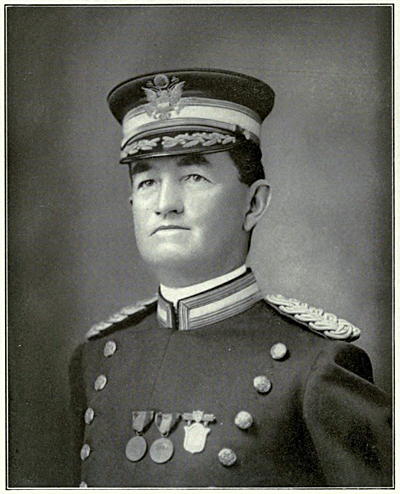 ¹
¹
Benjamin A. Poore
Photo taken while he was a Major in the 22nd Infantry 1908-1912
The following is Poore's
official military record, as contained in the Official US Army
Registers 1886-1928,
and from Cullum's registers of the graduates of the Military
Academy * :
Benjamin Andrew Poore was born
in Alabama on June 22, 1863. He entered the US Military Academy
at West Point,
from the State of Massachusetts, on September 1, 1882. On July 1,
1886, he graduated 33 out of a class of 77.
His best subjects were Spanish and French, and his worst subjects
were English and Mathematics. One of his classmates
and Class President, was John J. Pershing, who would later go on
to become General of the Armies. Another graduating classmate
was William M. Swaine, who was the son of Colonel Peter T.
Swaine, who, at that time, commanded the 22nd Infantry Regiment.
William M. Swaine would be the only graduating cadet to be
assigned to the 22nd Infantry from the US Military Academy in
1886.
Upon graduation, Poore was
commissioned a 2nd Lieutenant in the 12th Infantry, assigned to
Company A. He joined
the regiment at Madison Barracks, New York, on September 30,
1886, serving there until May 16, 1887, when he was
stationed at Fort Wood, New York. On July 25, 1887, he went with
the regiment to Fort Sully, South Dakota,
where he served on frontier duty until 1891. In that year he was
assigned to Company K.
In 1891 Poore attended the
Infantry and Cavalry School at Fort Leavenworth, Kansas. On
September 16, 1892,
he was promoted to 1st Lieutenant of the 10th Infantry. He was
transferred to the 6th Infantry on September 28, 1892,
and assigned to Company E. He graduated from the Infantry and
Cavalry School in 1893.
From 1893 to 1895 Poore was
detailed to the US Military Academy, as an instructor in the
Department of Modern
Languages. In 1895 he rejoined the 6th Infantry at Fort Thomas,
Kentucky, where he served on garrison duty until 1898.
With the outbreak of war with Spain, in 1898, he was sent to
Puerto Rico, as part of Brigadier General Theodore Schwan's
Independent Regular Brigade. He first served in the Bureau of
Military Information, then as the Brigade Commissary, and
afterward as the Adjutant-General of the Brigade and of the
Western District of Puerto Rico, July and August, 1898.
In Puerto Rico, Poore took part
in the skirmish at Guánica, July 25, 1898, and in the fight at
Hormigueros,
August 10, 1898, for which he was later awarded a Silver Star
Citation.
On October 18, 1898, he was appointed Quartermaster of the 6th Infantry Regiment.
Poore was promoted to Captain,
6th Infantry, on March 2, 1899. On March 9, 1899, he was relieved
of his duty as
Quartermaster, and the next day, March 10, he was appointed
Regimental Adjutant. In May 1899, he arrived with
his regiment in the Philippines. He commanded a detachment of the
6th Infantry in the fight at Guin-Tabuan, Island of
Negros, October 1, 1899, and took part in numerous minor
expeditions. For his services in the fight at Guin-Tabuan,
he was nominated for a brevet to Major, but the brevet was never
awarded. He was, however, awarded his second
Silver Star Citation for that action.
Poore left the Philippines in
June 1902, and arrived with the Regiment at Fort Leavenworth,
Kansas, in July 1902.
On March 9, 1903, he was relieved of his duty as Adjutant, and
given command of Company I. In February, 1905,
he left Fort Leavenworth, and returned to the Philippines in
April, 1905. He was on field service on the Island of Samar,
from May to December 1905. He left the Philippines in November,
1906, to be stationed at Fort Missoula, Montana.
|
Left: Captain Benjamin A. Poore 6th Infantry Fort Leavenworth, Kansas 1904
Photo from the Army and Navy Register August 6, 1904 |
On October 28, 1908, Poore was
promoted to Major of the 22nd Infantry. For approximately the
next five years
he would remain assigned to the 22nd Infantry. Toward the end of
1908, he reported to Washington, D.C.,
to attend the Army War College. He graduated from there in 1909
and joined the 22nd Infantry on duty at
Fort Seward, Alaska, as a battalion commander. He returned with
the Regiment to the continental
United States in 1910, commanding his battalion at Fort Sam
Houston, Texas, and on border duty, until 1912.
On July 1, 1912, Poore was
detailed to Washington, D.C., as a member of the General Staff.
He was appointed
Director of the Army War College in December of 1912. On June 25,
1913, he officially left the 22nd Infantry,
and became unassigned to any regiment.
On August 4, 1914, Poore was
promoted to Lieutenant Colonel of Infantry. On August 28 of that
year, his detail
to the General Staff ended, but less than a week later, on
September 3, he was again detailed to General Staff duty.
He left the War College in January 1916, and on January 19, 1916, his second detail to the General Staff ended.
He joined the 15th Infantry at their duty station in Tientsin, China, in April 1916.
On July 1, 1916, Poore was
promoted to Colonel of the 8th Infantry. He left the 15th
Infantry in October, 1916,
and joined the 8th Infantry at Fort William McKinley, at Manila,
in the Philippine Islands, in November of 1916.
He commanded the 8th Infantry from November 1916 to August 1917.
On August 5, 1917, Poore was
offered a temporary promotion to the rank of Brigadier General in
the National Army.
He accepted the position on September 6 of that year. He was at
Camp Pike, Arkansas, commanding the 162nd
Depot Brigade, from October to December 1917. From January to
March of 1918, he was at Fort Bliss, Texas,
commanding the 14th Infantry Brigade.
On April 4, 1918, Poore joined
the 4th Division at Camp Greene, North Carolina, as Commander of
the 7th Infantry Brigade.
He was at Camp Mills, New York, from April 30 to May 9, preparing
to take the Brigade overseas. On May 10, 1918, he
sailed to France with the Brigade and some of the artillery of
the 4th Division, arriving in Brest on May 23. From May 25
to June 9, he and the Brigade were enroute to, and in the British
Training Area near Samer, France, where they trained with
the British 16th Infantry Division. From June 10 to July 17,
Poore and his Brigade were in the French Training Area,
attached to the French 4th Infantry Division. They took part in
the Aisne-Marne offensive as follows: from July 18-23,
they were attached to 2nd French Corps and held in reserve; on
July 24, they were returned to the 4th Division, and held
in reserve for the 1st U.S. Corps; from August 3-12, they were in
the front lines and in the attack near the Vesle River;
on August 12 they were withdrawn from the front lines and sent to
the American training area.
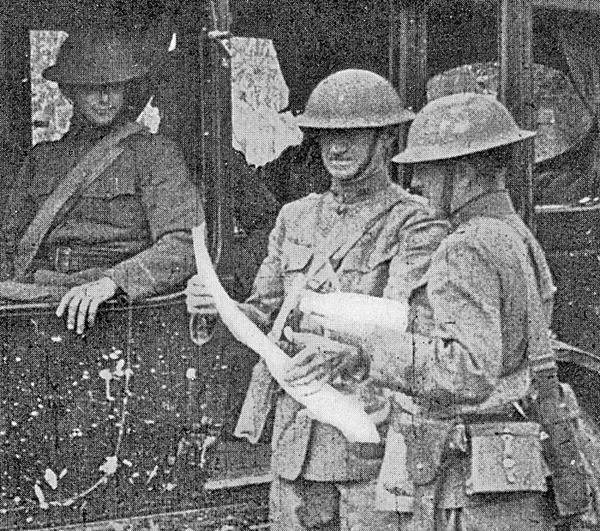
Brigadier General
Benjamin A. Poore (center) near Mareuil-en-Dôle in the Aisne
region of France
near the Vesle River August 1918.
Photo from THE THIRTY-NINTH IN
THE WORLD WAR by Col. Frank C. Bolles
Press of Joseph D. McGuire New York 1919
In August, 1918, Major General
George H. Cameron, commanding the 4th Division, was promoted to
command of V Corps,
and Poore took temporary command of the 4th Division. The dates
of Poore's first command of the 4th Division,
are reported differently in his official biography as written in
Cullum's Register, and in the official history of the
4th Division. In Cullum's Register, Poore is noted as commanding
the Division from August 14-28, and in the
history of the 4th Division published just after the war, the
dates are noted as August 16-27.
When Major General John L. Hines
assumed command of the 4th Division at the end of August, Poore
returned to
command of 7th Brigade. From September 12-14, 1918, Poore and his
Brigade were engaged in the St. Mihiel offensive
as the reserve for V Corps. They were then withdrawn from the
front and sent to the training area from September 15-25.
On September 26, 1918, Poore and
his 7th Brigade, led the attack by the 4th Division in the
Meuse-Argonne Offensive.
They continued to lead the attack for two days, until, on
September 29, they were withdrawn from the front and placed
in reserve for III Corps, until October 9. On October 9, in the
second phase of the Meuse-Argonne Offensive,
Poore and his Brigade again led the attack by the 4th Division,
under command of III Corps. By October 19, they
were relieved of their front line duties, and sent to a rear
training area. During those two engagements, Poore was decorated
twice, with the Distinguished Service Medal for his leadership,
and the Distinguished Service Cross for his personal bravery.
General Cameron had returned to
command the division on October 10, but rotated back to the U.S.
on October 22,
at which time Poore again assumed temporary command of the 4th
Division. He continued in command until October 31,
when he relinquished command to Major General Mark L. Hersey.
Poore and 7th Brigade remained in the training area
until November 19, except for the two days of November 10-12,
when they were held in reserve for IV Corps.
On November 20, 1918, the 4th
Division began the march into Germany for occupation duties,
crossing the Moselle River
onto German soil on December 3. By December 17, the Division was
settled into its area of occupation, and Poore made his
headquarters in the city of Adenau. Near Büchel, Germany, on
March 18, 1919, the commander in chief of US forces in Europe,
General John J. Pershing, was present, as the 4th Division was
formed for inspection and the awarding of decorations.
The first awards of the day were bestowed upon Poore, when he
received from Pershing the Distinguished Service Cross
and the Distinguished Service Medal.
On June 29, 1919, the 4th
Division Association was formed, in a convention made up of
representatives of officers and
enlisted men of the Division. Benjamin Poore was selected as the
first President of the Association.
On July 8, 1919 Poore and the
4th Division began the process of leaving Germany for return to
the United States.
He departed by ship from Brest, France on July 24, arriving in
New York on August 1. His next assignment was
Commander of the Demobilzation Center at Fort D.A. Russell,
Wyoming a position he held until February 1, 1920.
From February 1 to March 15, 1920 he commanded a Provisional
Brigade of the 1st and 35th Infantry at
Camp Lewis, Washington.
On March 15, 1920 Poore was
honorably discharged from his Brigadier General rank in the
National Army and was
returned to the grade of Colonel in the Regular Army. He assumed
command of the 1st Infantry and was stationed at
Camp Lewis, Washington, Vancouver Barracks, Washington and Camp
Travis, Texas. While at Camp Travis during
the summer of 1921 he also commanded the Citizen's Military
Training Corps there.
On December 21, 1921 Poore was promoted to Brigadier General, a position which he accepted on December 22.
He was assigned to command of
4th Brigade 2nd Division at Fort Logan, Colorado. During the
summer of 1922
he also commanded the Reserve Officers Training Corps, the
Citizen's Military Training Corps and the Officer
Reserve camps at Fort Logan.
Poore relinquished command of
4th Brigade on November 13, 1924 and went to Fort Sheridan,
Illinois where he
assumed command of 12th Brigade. During the summer of 1925 he was
at Camp Custer, Michigan commanding
the Reserve Officers Training Corps, the Citizen's Military
Training Corps and the Officer Reserve camps.
On October 11, 1925 Poore was
promoted to Major General and was assigned to command of 7th
Corps Area
at Omaha, Nebraska. He held this position until June 22, 1927
when he was retired from the Army after 45 years
of service.
He was awarded the French Legion
of Honor and Croix de Guerre and the Italian Croce al Merito di
Guerra.
He was also a member of the Military Order of the Carabao.
|
Brigadier General Benjamin A. Poore Poore is wearing the 4th
Division Photo from: THE FOURTH DIVISION Its Services and Achievements by Christian A. Bach and Henry Noble Hall Issued by the Division 1920 |
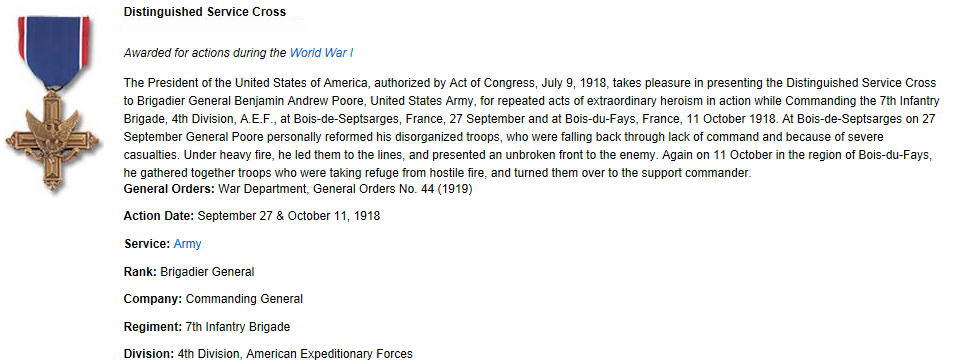 °
°
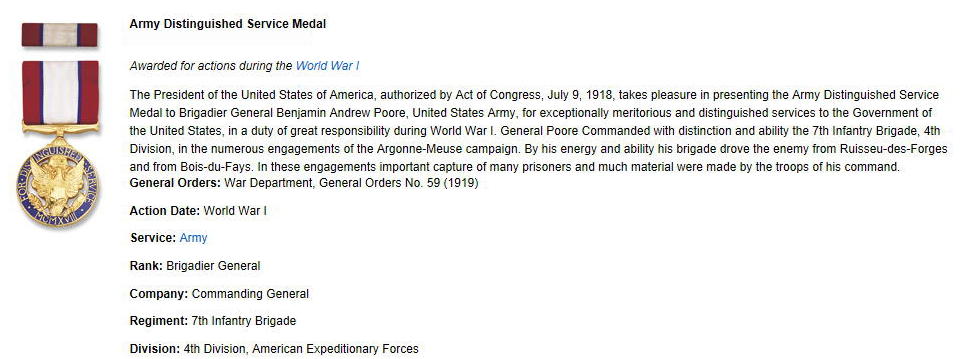 º
º
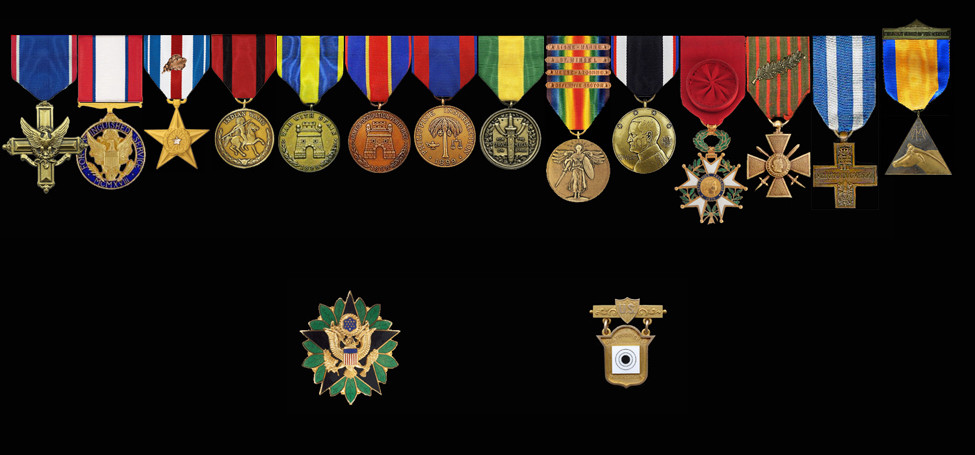
Benjamin A. Poore's decorations

Benjamin Andrew Poore
Major, 22nd Infantry. Station: Fort Sam Houston, Texas.
WAR AND FIELD SERVICE: Campaign
in Porto Rico, 1898, and Philippine insurrection, 1899-1902;
in actions at Guanica, Porto Rico, July 25, Hormigueros, Porto
Rico. August 10, 1898, Guin-Tabuan,
Negros, Philippine Islands, October 1, 1899; engaged in numerous
minor expeditions in Philippine Islands, 1899-1902;
on field service in Samar, Philippine Islands, May to December,
1905.
SPECIAL DUTY: Distinguished
graduate, Infantry and Cavalry School, 1893; with Bureau of
Information at Tampa
and Key West, Florida, Santiago de Cuba, and Porto Rico, May,
June and July, 1898. Instructor, Department of
Modern Languages, U. S. Military Academy, 1903-05; Army War
College, 1909.
PERSONAL HISTORY: Born June 22,
1863, Center, Alabama. Married Addie Johnson Carleton, June 20,
1888,
Salem, Massachusetts. Children : Katharine Hale Poore, born July
25, 1889, Fort Sully, South Dakota;
Priscilla Carleton Poore, born February 4, 1896, Fort Thomas,
Kentucky; Adelaide Carleton Poore, born
December 29, 1899, Fort Sam Houston, Texas. Married children :
Katharine Hale Poore ; married 2nd Lieutenant
Joseph O. Mauborgne, 6th Infantry (now 1st Lieutenant, 3rd
Infantry), at Missoula, Montana, December 3, 1907;
now residing at Fort Leavenworth, Kansas. Grandchildren: Joseph
O. Mauborgne, Jr., born October 22, 1908,
at Fort Missoula, Montana. ¹
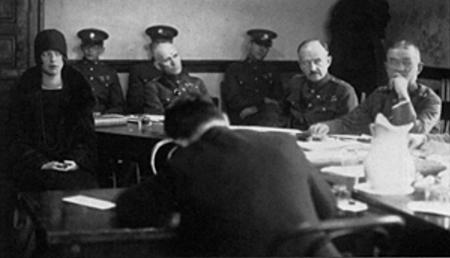
October-December 1925 trial of Billy
Mitchell. Margaret Lansdowne, widow of the skipper of the airship
Shenandoah,
testifies on behalf of General Mitchell. Major General Benjamin
A. Poore is seated as a member of the board, far right.
He was one of the judges in the famous trial, and voted Mitchell
guilty of insubordination.
Photo via Library of Congress
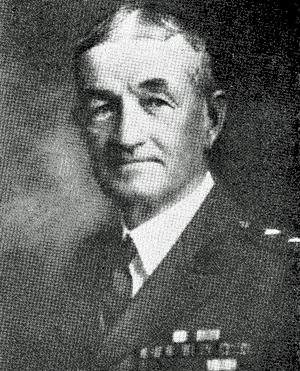
BENJAMIN ANDREW POORE was born
June 22, 1863, at Center, Alabama. His father, Andrew Poore, then
sixty-nine years of age, was a veteran of the War of 1812, having
served at Fort Warren in 1814. His grandfather's name
appears on Revolutionary records. While he was still an infant,
his mother died, and at the age of four "Benny" came
with his sister to Fitchburg, Massachusetts, to be brought up by
his half brother. Educated in the public schools,
he went to high school the youngest in his class and graduated at
sixteen. After two years in the mechanical trade
he entered the United States Military Academy in 1882, graduating
in 1886, a classmate of General Pershing and many
other distinguished officers. There followed forty years of
active military service during which he was stationed at
more than twenty-five different army posts throughout the country
as well as others in Alaska, Puerto Rico,
the Philippine Islands, Tientsin, China, France, and Germany.
He was first attached to the
12th Infantry from 1886 to 1891. A distinguished graduate of the
Infantry-Cavalry School in 1893,
he went to the United States Military Academy as instructor for
the next two years and then served with the 6th Infantry
until 1907. During this twelve year period, he saw active service
in Puerto Rico and twice in the Philippine Islands.
In Puerto Rico he was Adjutant
General of General Schwan's Brigade and participated in the
engagement at Guanica
and at Hormigueros. For gallantry in action against the Spanish
force at Hormigueros, August 10, 1898, he was awarded
a silver star citation. In the Philippine Islands he participated
in the engagement at Guintabuan and was awarded a second
silver star citation for gallantry in action against Insurgent
forces in Tabuan, Negros, October 1, 1899.
After a year as a student at the
Army War College he was attached to the 22nd Infantry with which
he remained until 1912.
In the summer of 1907 he was a competitor in the Northern Rifle
Competition at Fort Sheridan and held a medal as a
distinguished marksman. Following assignment on the War
Department General Staff at Washington, D. C., he was appointed
Director of the Army War College, which office he held until
1916, when he was sent to Tientsin, China, on foreign service
with the 15th Infantry. On July 1, 1916, he was promoted to the
grade of colonel and assigned to the command of the
8th Infantry at Fort William McKinley, Philippine Islands.
Returning to the United States in August, 1917, as a Brigadier
General,
National Army, he commanded the 162nd Depot Brigade at Camp Pike,
Arkansas, the 14th Infantry Brigade at El Paso,
Texas, the 7th Infantry Brigade at Camp Greene, North Carolina,
and Camp Mills, Long Island, and then sailed for France
with that brigade on May 10, 1918, to serve with the American
Expeditionary Forces as a unit of the 4th Division
until the end of the war and thereafter in the Army of Occupation
in Germany.
He participated in the Aisne-Marne, Meuse-Argonne, and St. Mihiel Offensives and received the following awards:
The Distinguished-Service Medal with the following citation:
For exceptionally
meritorious and distinguished services. He commanded with
distinction and ability the 7th Infantry Brigade,
4th Division, in the numerous engagements of the Argonne-Meuse
campaign. By his energy and ability his brigade drove
the enemy from Ruisseau-des-Forges and from the Bois-du-Fays. In
these engagements important captures of many prisoners
and much material were made by the troops of his command.
The Distinguished-Service Cross with the following citation:
For extraordinary heroism in
action. At Bois-des-Sept-sarges on Sept. 27, General Poore
personally re-formed his disorganized
troops, who were falling back through lack of command and because
of severe casualties. Under heavy fire, he led them to
the lines, and presented an unbroken front to the enemy. Again on
October 11, in the region of Bois-du-Fays, he gathered
together troops who were taking refuge from hostile fire, and
turned them over to the support commander.
From the spring of 1920 for
almost two years he commanded the 1st Infantry at various
stations. On December 21, 1921,
he was appointed Brigadier General, Regular Army, and commanded
the 4th Infantry Brigade until 1924 and the 12th Infantry
Brigade until 1925. On October 11 of that year he was promoted to
the grade of major general and assigned to command
the Seventh Corps Area with headquarters at Fort Omaha, Nebraska.
This was his final assignment. He retired for age on June 22,
1927.
In June, 1888, he married Addie
Johnson Carleton at Salem, Massachusetts, and she was his
constant and devoted companion
for over forty years, except during active war-time service. They
had four daughters. After retirement in 1927 he planned to
travel and then make a permanent home in Washington. While on a
round-the-world cruise his wife became ill and they returned
to this country. She died in Washington during February, 1929. In
1930 he came back to Fitchburg, Massachusetts,
and in October married Flora B. Bullock, widow of Brigham N.
Bullock. There followed ten very happy years in the
Fitchburg home. During that period he went several times to West
Point, which he dearly loved. There was never a more loyal
or devoted son. His fiftieth reunion was an outstanding event,
and he was greatly anticipating the fifty-fifth.
He watched closely the
development of near-by Fort Devens and the summer activities of
the C.M.T.C. His recreation
in later years was motoring and, in the fall season, the shooting
of the New England ruffed grouse; he never lost his marksmanship.
It had been my happy privilege
to have his friendship and affection since boyhood. Often on
furlough he came to see
his people in Fitchburg and on one such occasion brought to me
jungle trophies from the Philippine Islands—bolo knife,
machete, dagger, and other weapons that simply thrilled. Little
did I realize that one day he would live in my home,
that for him I would have the respect, admiration, and love that
I would have had for my own father, and that I would feel
so keenly his loss. During a lifetime one knows few such men.
His widow, his sister, a niece,
three daughters, and nine grandchildren survive. The daughters
all married army officers—
Maj. Gen. Joseph O. Mauborgne, Brig. Gen. Donald A. Robinson, and
Lt. Col. Charles L. Bolte, whose records and
accomplishments were to him a source of great pride and joy.
Following his death on August
27, 1940, a service was held in Fitchburg at the Unitarian Church
which he had served
as Trustee, and final services with military honors were
conducted on the 31st at Arlington National Cemetery. Very
fittingly
the escort consisted of a battalion of the 12th Infantry, with
the 3rd Cavalry Band, and the salute was fired by a battery of
the
16th Field Artillery. Uniformed members of the Legion of Valor,
several of whom were from General Poore's home state
of Massachusetts, and two of whom had served in his brigade
during the World War, were in attendance.
Honorary pall bearers included Maj. Gen. M. M. Patrick,
U.S.A.—Ret., and Brig. Gen. T. H. Rees, U.S.A.—Ret.,
both of whom were classmates of the deceased at West Point; Lt.
Col. Henry Terrell, Jr., and Lt. Col. C. H. Karlstad,
who served with General Poore during the war; Lt. Col. C. S.
Kilburn; and Maj. N. F. Twining, who was at one time his aide.
General George C. Marshall, Chief of Staff, took time from his
busy desk to pay a last tribute to the distinguished soldier.
—R. B. ²
Benjamin A. Poore died at Fitchburg, Massachusetts on August 27, 1940
He is buried in Arlington National Cemetery
Section 4 Grave 3310
He was interred in Arlington on August 31, 1940
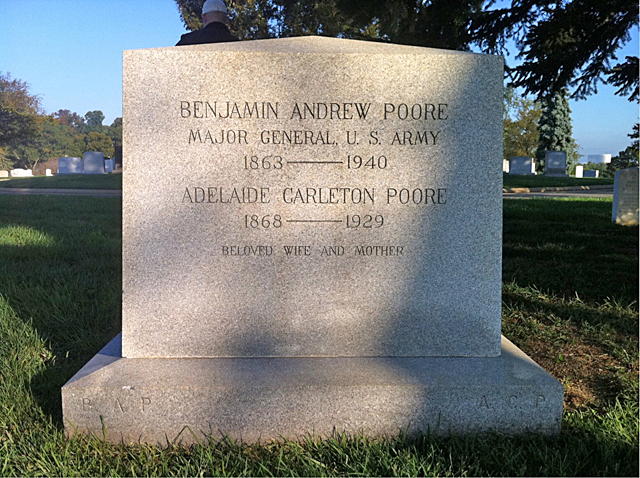
Grave marker for Benjamin A. Poore
Photo from the Official Arlington National Cemetery website
¹ 1886-1911 In Commemoration of the 25th Anniversary of Graduation of the Class of '86, U.S.M.A.,West Point, June, 1911
² SEVENTY-SECOND ANNUAL REPORT of the
Association of Graduates of the
United States Military Academy West Point, New York June 10,
1941,
The Moore Printing Company, Inc., Newburgh, New York
Much of the detail concerning Benjamin Poore's
duty with the 4th Division was taken from:
THE FOURTH DIVISION Its Services and Achievements in the World
War
by Christian A. Bach and Henry Noble Hall, Issued by the Division
1920
* BIOGRAPHICAL
REGISTER of the OFFICERS AND GRADUATES of the U.S. MILITARY
ACADEMY
at West Point, New York, Since Its Establishment in 1802 by
Brevet-Major-General George W. Cullum
VOL. III 1891, Supplement VOL. IV 1901, Supplement VOL. V 1910,
Supplement VOL. VI-A 1920,
Supplement VOL. VII 1930
º Military Times Hall of Valor
Home | Photos | Battles & History | Current |
Rosters & Reports | Medal of Honor | Killed
in Action |
Personnel Locator | Commanders | Station
List | Campaigns |
Honors | Insignia & Memorabilia | 4-42
Artillery | Taps |
What's New | Editorial | Links |